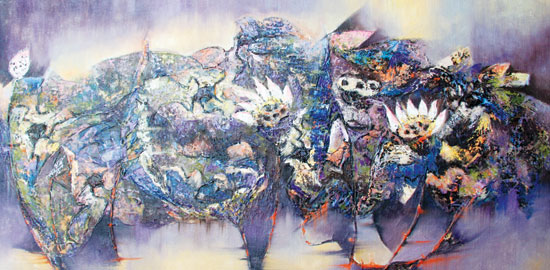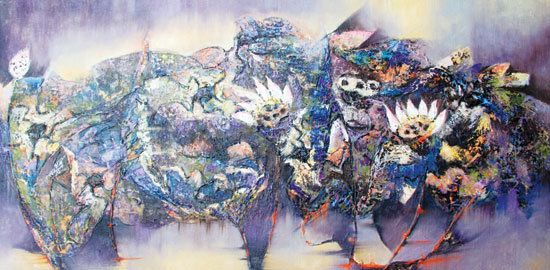No 3, Vol.11 , October – November 2015
Capturing the essence of the land and sea on canvass where I grew up would be a priority for me if God had given me artistic talent. Like the artist Tran Manh Duc, I grew up on the edge of a small town and so close to the sea that seagulls flew above me as I played in the street. That was Kent – the garden of England. Tran Manh Duc is from rural Khanh Hoa Province, which has the famous beach resort of Nha Trang as its capital-picturesque, too, but in a very different way. I went to an exhibition of eighteen pictures of his that celebrate the elements, the beauty and the soul of his countryside. It is in the Tu Do Gallery, one of the oldest in Ho Chi Minh City. You can not miss it. It is directly opposite the main entrance to the iconic Bitexco Tower, the city’s highest building.
The overall feeling you get from viewing the eighteen frames in the exhibition hall is one of warmth and joy. This emanates in no small part from the exuberant use of colour and light. Each picture has a main colour- be it golden, violet or red-with supporting ones. The gallery owner explained to me that in the two in which crimson red dominate, that the artist has been inspired by the technique and composition of Vietnamese lacquer painting. All the pictures are in fact, oil on canvass. The style could be said to be mainly expressionism, with some abstract and some fairly obscure depictions of people, landscapes and markets.
On my hour-long visit, I was fortunate to have for company and guide the owner, seventy-seven-year old Mr Dong Hai Son. It began to rain heavily for an hour soon after I arrived, so nobody entered to disturb us. Mr Son, who speaks excellent English, taught me a lot about Vietnamese art, especially lacquer painting. He often promotes Vietnamese art in the United States and owns a gallery there. Perhaps because he wanted to practice his English, I found Mr Son to be a great conversationalist and our talk extended to well beyond the boundaries of art. I hope you will be lucky enough to meet him.
Our first stop was before what vaguely looked liked a landscape. I could make out a twisting mountain road and perhaps there were fields down in a valley, I told the galley proprietor. ‘You are right.’ replied Mr Son, ‘this painting is inspired by the mountain pass that leads from Khanh Hoa to the Central Highlands’.
Then it was on to a pair with more realistic elements, entitled ‘Fishermen’s Hamlet’. It was only with some help from Mr Son that I was able to work out that the thatched yellow and reds depicted a fish market, but the actual fishermen in their conical hats were clear enough. The artist clearly conveyed to me his love for those who devote their lives to the sea.
The next pair was much more abstract-colourful wavy lines crossed by swathes of cloudy white. One was vertically arranged; the other horizontal. The idea here, Mr Son explained, was to give you the feeling of the wind – the artist comes from a particularly windy section of the coast.
One picture I particularly liked was a landscape of jagged grey mountains topped with white clouds, but the predominant colour being a warm gold suggested that it was bathed in sunshine. This came with the mysterious title ‘Echoes’.
We passed on to a series of frames, variations on a theme, called ‘Lotus One, Two, Three, Four and Ten.’ The artist clearly loves this flower and one imagines it grows abundantly in his homeland. Silver, blue, ochre and crimson are the main colours here, with the flowers tightly bunched together. The soothing powers of flowers come across clearly, although in one of swirling lines there is the suggestion they may be agitated by the wind.
Following this, we viewed another series, ‘Homeland Three through to Six’. These were quite abstract and varied. One was an almost Scottish tartan enveloped in golden colour – it spoke to me of fields in the bright sunshine. Another featured flowers, but not lotus this time. All these, it seemed, were images of aspects of the artist’s ‘Que Huong’ (home area), for which he has particular love and warm feelings and which he wishes to communicate to the world.
The final series of four, with the title ‘Serene’, uses light beautifully and is very abstract. I liked best the one in which crimson predominates and is centred on a rough outline of a fish dazzling in light as if freshly drawn from the sea.
Art can have many functions. If you are fond of paintings that act as a ‘de-stressor’-a tonic to counter the hurly-burly life, then Tran Manh Duc’s selection is for your viewing. You will come away soothed as much as you would be from sitting in an armchair and listening to a romantic symphony. By the time this goes to print, the exhibition will be over-but do not worry; three or four will be left for permanent exhibition. Furthermore, I am informed the others will be held in a back room for six months and the interested art lover can request to see them. Dear reader, I hope you will enjoy this show as much as I have.
Tran Manh Duc’s paintings sell for between $800 and $2,400.n
The exhibition ‘Hon Que va Bien’ (Homeland and Sea) was held from 1 September to 28 September, 2015 at Tu Do Gallery, 53 Ho Tung Mau St, Dist.1,
Ho Chi Minh City. Tel: (08) 3821-0966, Email: tudogallery@hcmc.vnn.vn,
www.tudogallery.com

